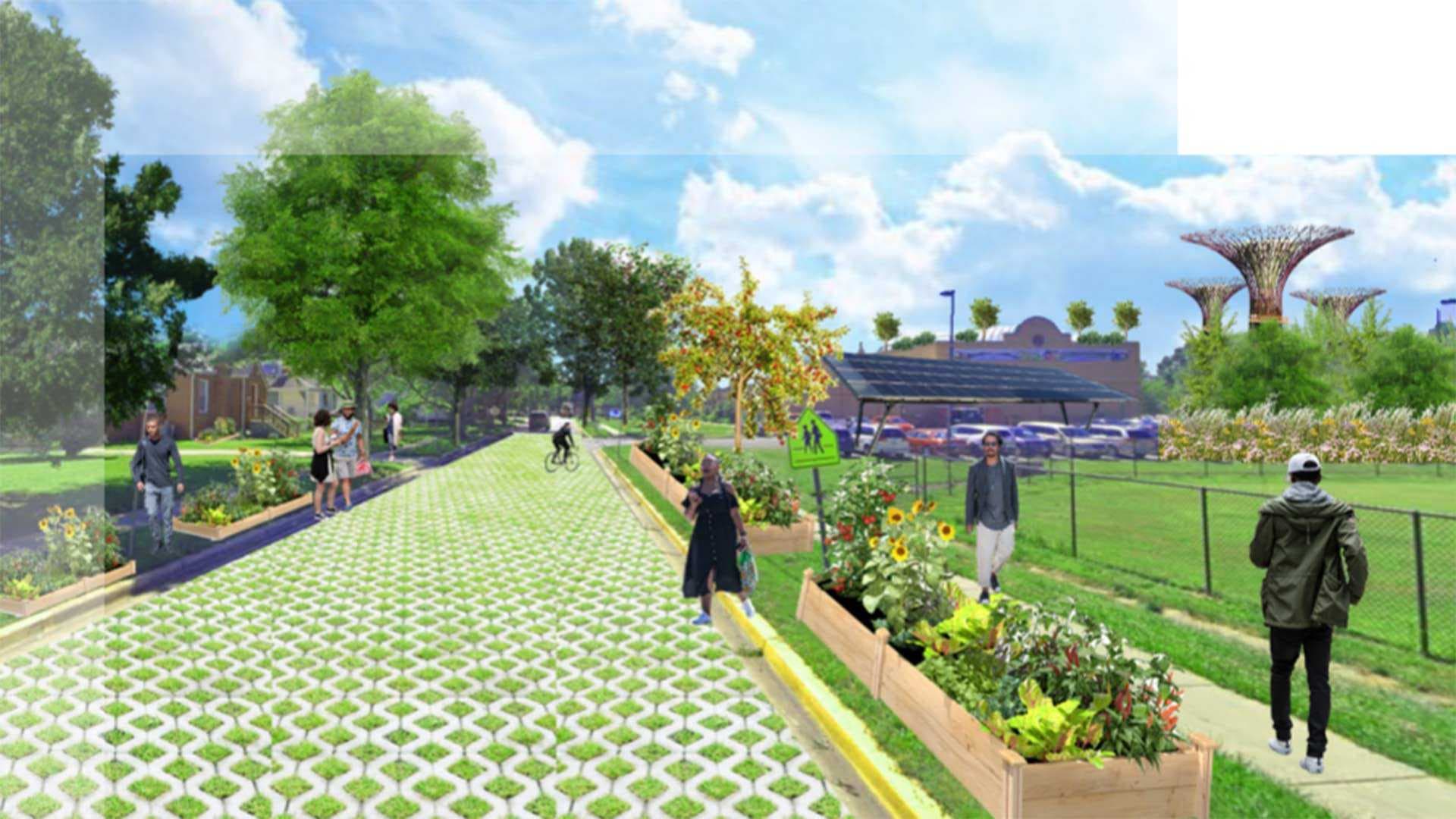Can a Fractured Community Be Made Whole?
UMD Project Envisions Possible Futures for a Marginalized Corner of College Park

Future visions of a more connected, equitable and sustainable community devised by urban planning students this semester hope to inspire the City of College Park’s efforts to bring restorative justice to Lakeland. A rendering of the neighborhood's Pierce Avenue in 2023 includes widespread urban agriculture, solar-covered parklets and permeable pavers.
Rendering by Rachel Whiteheart
The intersection of Rhode Island Avenue, Lakeland Road and Navahoe Street in the College Park neighborhood of Lakeland holds two pasts: One is of streetcars and Saturday night socials, corner stores and community parades; the other, of bulldozers, displacement and the erasure of a once-vibrant community.
This fall, a University of Maryland urban planning project looked to recapture what made Lakeland a thriving African American community before the devastating impact of racially-charged urban renewal—and imagine its future. The project, developed in partnership with the city of College Park, Lakeland residents and the university’s Partnership for Action Learning in Sustainability (PALS) program offered three future scenarios for Lakeland in 2033 and demonstrated how policies, planning interventions and neighborhood investments might bring renewed opportunity, hope and healing.
“We recognize that this is a journey many of you have been on, and will continue on, for decades,” said urban studies and planning student Rachel Whiteheart to Lakeland residents, College Park Mayor Patrick Wojhan, city council members and members of the university community at the students’ final presentation last week. “Our intention is to support the city of College Park and the Lakeland community in their collaborative path to promoting actions that honor the past, understand current needs and build a more just future.”
Established at the turn of the 20th century, Lakeland was once a prosperous, tight-knit African American hamlet anchored by faith and community on the east side of a segregated College Park; at a time when commercial businesses along Baltimore Avenue banned Black patrons, generations of Lakelanders built homes and churches, opened grocery stores and social clubs, lobbied for schools, and established their own municipal services. In 1970, an urban renewal project billed to address the town’s recurrent flooding and replace its deteriorating housing decimated Lakeland, leveling 104 out of 150 historic homes and destroying cherished community places.
In 2020, the city of College Park began efforts to make reparations for the harm caused to Lakeland residents, issuing a formal apology and forming the Restorative Justice Commission.
Strategic plans like the College Park City-University Partnership’s University Community Vision 2030, trend and demographic analysis, interviews, online surveys and a fall community engagement event helped the students pinpoint areas where government and community could take action. While not intended to be a road map, the scenarios outlined by the students offer options and strategies for the city, commission and community to consider in planning Lakeland’s future.
“They put ideas on the table, which will be useful to the community as they re-envision Lakeland’s future,” said College Park Planning Director Terry Schum.
Under the direction of Urban Studies Professor Clara Irazábal, students developed a “status quo” scenario that envisioned what Lakeland would look like under no policy change, a “reform” scenario that imagined the impact of creative regulation reform, planning and design, and what students call a “revolutionary” scenario: bold policy decisions and investment that provide opportunities for Lakeland to achieve economic stability, community power, strength and healing.
“You hear about diversity and equity but they’re not just words,” said Maxine Gross, chair of the Restorative Justice Commission and a resident of Lakeland. “The nuances of this project made it particularly challenging, but the students did a good job bringing some of those concepts to life.”
While the status quo scenario portrays a community squeezed by continued development along Route One, rising housing costs and unrelenting flooding, the reform and revolutionary scenarios envision a sustainable, connected Lakeland that is rich in preserved history and culture: new social gathering spaces, a pedestrian bridge that reconnects areas fractured by urban renewal, multigenerational housing for legacy residents and university students, renewable energy projects and the historic designation of a longtime community church.
While imaginative vehicles for visualizing what’s possible, the students agreed that the most important work for realizing restorative justice for Lakeland must run deeper.
“The most important suggestions aren’t the physical changes, but rather changes in where the power systems lie,” said architecture and urban studies and planning student Danielle Abe. “A lot of planning approaches have historically been very top-down, and one of the potential ways to shift the role of planning is put it in the hands of those who know their communities best.”